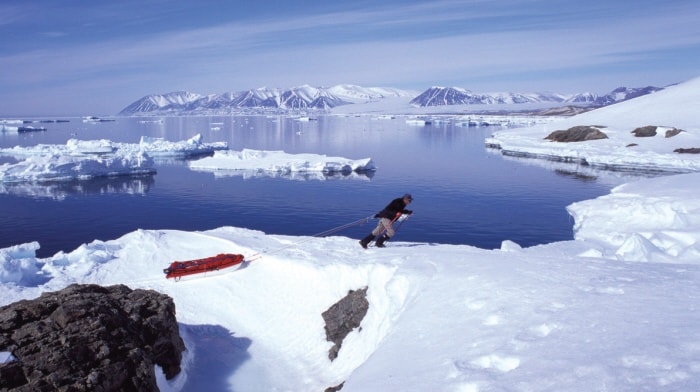Modern day explorer John Dunn shared experiences and told stories as he painted an intriguing picture of Canada’s high arctic for students at Poplar Ridge School Nov. 1.
Born and educated in England, he moved to Canada in the late 1980s and has been pursuing his dream of exploring and photographing the arctic.
He’s completed 20 expeditions, totalling over 1,100 days in the field.
Dunn focused his presentation on a 600 kilometre human powered journey around the edges of Devon Island and over the ice cap, a trip he did in May and early June of the year he travelled.
Photographs and videos enthralled students who listened and learned.
He and a partner pulled sleds loaded with supplies and food for a month or two during their journeys into the wilderness “seeing the wonderful things out there”.
Much of his trips is spent skiing and pulling sleds close to the coastline because there’s more wildlife near the ocean.
Dunn explained that because humans are number two on the food chain (polar bears might eat you), he and his travelling companion don’t do any hunting or fishing. They keep their camp very clean and uninteresting for bears.
“I really liked this place (Devon Island) so I have gone a couple of times,” he said. “We work very hard but our reward is being out there enjoying the area.”
He said they did meet bears but were able to avoid close contact by their vigilance or by waiting for bears to move along.
Showing pictures of some of the polar bears they met, Dunn said on his three trips to the island they saw 80 polar bears. And he showed the sightings plotted on a map indicating their preference to stay near the shores and their all important source of food — seals.
“We’re always looking around at interesting stuff,” he said.
Devon Island is now uninhabited but the Inuit used to live there and have left the remains of their camps.
Dunn described Muskox as “probably my favourite Arctic animal. They’re very well adapted animals.”
Travelling along the coastline can be treacherous, he showed in some of his pictures, as ice might break off and float out to the ocean when warmer weather arrives.
During his travels they were sometimes hiking on water covered ice which had resulted from melting glaciers flowing down to the water’s edge.
“As the ice is breaking up we have to be creative about how we get across open water,” he said, showing pictures of various portage methods. In one case they turned their sled into a boat and paddled around the coast.
Another instance showed a sail rigged to their sleds to help with pulling.
“How do you go on without any snow (when it’s melted)?” he asked. “You get inventive again.” In that instance he showed a picture of wheels added to their sleds. “It’s fun to solve all the problems along the way.”
At one location they stopped at a building built by the RCMP when they had a station on the island at Dundas Harbour. Another picture of that location showed an arctic hare beside the long since abandoned out house.
At a certain stage in their trip they started to climb the ice cap to get over to the other side of the island. The dangers of fissures in the ice and fast flowing melt water rivers were emphasized as he guided students through his journey.
Following his presentation, students showed their obvious interest with many questions.
Dunn lived in Canmore but is currently living in Switzerland. To learn more or see his photography check the website www.arcticlight.com.
